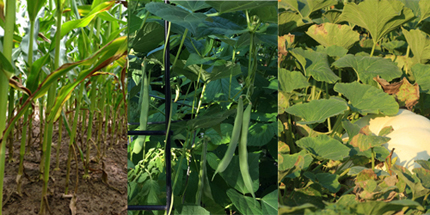Soil Science Society of America
5585 Guilford Road • Madison, WI 53711-5801 • 608-273-8080 • Fax 608-273-2021
www.soils.org
Twitter | Facebook
NEWS RELEASE
Contact: Hanna Jeske, Associate Director of Marketing and Brand Strategy, 608-268-3972, hjeske@sciencesocieties.org
How do the “three sisters” plants work together?
June 1, 2017 – Corn, beans, and squash—the “three sisters”—have traditionally been grown together for best results. The Soil Science Society of America (SSSA) June 1 Soils Matter blog post explains how companion plantings use plants' strengths to their best advantage.
 “Cooperative synergy is behind the approach of companion planting,” says Farrah Fatemi. Fatemi is assistant professor of environmental studies at St. Michael’s College in Vermont. “In companion planting, ecologically complementary crops are grown alongside one another. Native tribes in North America, most notably the Iroquois, utilized the three sisters approach.”
“Cooperative synergy is behind the approach of companion planting,” says Farrah Fatemi. Fatemi is assistant professor of environmental studies at St. Michael’s College in Vermont. “In companion planting, ecologically complementary crops are grown alongside one another. Native tribes in North America, most notably the Iroquois, utilized the three sisters approach.”
- Corn, with its tall, strong stalk, is the leader.
- Beans, which climb the corn stalks, bring the gift of nitrogen fixation, They work with soil bacteria to provide vital nitrogen.
- Squash has broad and prickly leaves to protect the soil, prevent weeds, and reduce pests.
Other companion plantings, such as radish-spinach-bush beans, take advantage of fungi in the soil.
“Companion planting is a great way to promote crop productivity by harnessing natural synergies in the soil/plant system. Ultimately, this strategy can make for healthier ecosystems by reducing the need for synthetic fertilizers and pesticides,” Fatemi explains.
To read the entire blog post, visit https://soilsmatter.wordpress.com/2017/06/01/how-do-the-three-sister-plants-work-together/.
Follow SSSA on Facebook at https://www.facebook.com/SSSA.soils, Twitter at SSSA_Soils. SSSA has soils information on www.soils.org/discover-soils, for teachers at www.soils4teachers.org, and for students through 12th grade, www.soils4kids.org.